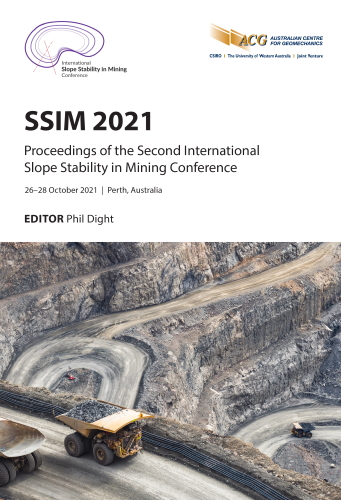Improving bench design through discrete fracture network analysis

|
Authors: Valerio, M; Rogers, S; Lawrence, KP; Byrne, C; Veltin, K; Darakijan, T; Gaida, M; Cambio, D; Chapin, GK |
DOI https://doi.org/10.36487/ACG_repo/2135_29
Cite As:
Valerio, M, Rogers, S, Lawrence, KP, Byrne, C, Veltin, K, Darakijan, T, Gaida, M, Cambio, D & Chapin, GK 2021, 'Improving bench design through discrete fracture network analysis', in PM Dight (ed.), SSIM 2021: Second International Slope Stability in Mining, Australian Centre for Geomechanics, Perth, pp. 457-472, https://doi.org/10.36487/ACG_repo/2135_29
Abstract:
Discrete fracture network (DFN) analysis methods can assist in our understanding of bench-scale slope performance in open pit mines and provide results that are more representative of structural conditions compared to conventional kinematic methods. Conventional kinematic analysis may not adequately capture the complexity of the fracture network and its impact on bench-scale stability because this method is typically limited to analysis of simple rock blocks or wedges formed by one or two fracture sets only. This simplification of block geometries, combined with the limitation of not adequately representing variations in the location and spacing of discontinuities forming blocks, can result in significant differences between theoretical and observed bench performance. DFN methods provide an alternative approach to conventional kinematic methods to model the structural fabric. The fracture networks developed through DFN modelling incorporate variations in the location, spacing, and persistence of discontinuities. DFN-based approaches allow more detailed analysis of the probability of occurrence, probability of failure, and expected back-break when compared to conventional kinematic methods as wedge geometries are more explicitly defined from observed features. This paper provides a comparison between conventional kinematic analysis and a DFN-based approach to bench design, with a focus on back-break metrics for two case studies: one slope governed by potential planar instability and a second where potential wedge failure is the controlling mechanism. The impact of mining processes and time-dependent rock mass degradation on observed back-break is discussed. Comparison between the results of both conventional kinematic and DFN methods to actual bench performance observed at the Bingham Canyon Mine indicates that the DFN approach can deliver results that are more structurally representative of field conditions.
Keywords: bench design, discrete fracture network, kinematic analysis, back-break, bench performance
References:
Golder Associates Inc. 2021, FracMan, version 8.0, computer software, Golder Associates Inc, Redmond, https://www.golder.com/fracman/
Hoek, E, Bray, JW & Boyd, JM 1973, ‘The stability of a rock slope containing a wedge resting on two intersecting discontinuities’, Quarterly Journal of Engineering Geology and Hydrogeology, vol. 6, no. 1, pp. 1–55.
John, KW 1968, ‘Graphical stability analyses of slopes in jointed rock’, Journal of the Soil Mechanics and Foundations Division, vol. 94, no. 2, pp. 497–526.
Kovári, K & Fritz, P 1975, ‘Stability analysis of rock slopes with plane and wedge failure by means of a pocket calculator’, Proceedings of the 16th US Symposium on Rock Mechanics, American Rock Mechanics Association, Alexandria.
Langford, JC, Corkum, B & Curran, JH 2014, ‘Preliminary selection of optimum bench face angle using uniformly distributed wedges’, Proceedings of the 1st International Conference on Discrete Fracture Network Engineering, Canadian Rock Mechanics Association, Vancouver.
Libby, S, Hartley, L, Turnbull, R, Cottrell, M, Bym, T, Josephson, N… & Ivars, DM 2019, ‘Grown discrete fracture networks: a new method for generating fractures according to their deformation history’, Proceedings of the 53rd US Rock Mechanics/Geomechanics Symposium, American Rock Mechanics Association, Alexandria.
Londe, P, Vigier, G & Vormeringer, R 1969, ‘Stability of rock slopes – a three-dimensional study’, Journal of the Soil Mechanics and Foundations Division, vol. 95, no. 1, pp. 235–262.
Mathis, JI & Elmouttie, MK 2018, ‘Bench face angle variation from designed due to mapping bias and implementation practices’, Proceedings of the 2018 International Symposium on Slope Stability in Open Pit Mining and Civil Engineering, Seville,
pp. 1898–1917.
Miller, SM 1983, ‘Probabilistic analysis of bench stability for the use in designing open pit mines’, Proceedings of the 24th US Symposium on Rock Mechanics, College Station, pp. 621–629.
Miller, SM, Girard, JM & McHugh, EL 2000, ‘Computer modeling of catch benches to mitigate rockfall hazards in open pit mines’, Proceedings of the 4th North American Rock Mechanics Symposium, American Rock Mechanics Association, Alexandria, pp. 539–545.
Ortiz, R & Silva, R 2009, ‘Probabilistic analysis of bench-scale stability through diverse analytical tools’, Proceedings of the 2009 International Symposium on Slope Stability in Open Pit Mining and Civil Engineering, Santiago.
Rocscience 2021a, RocPlane, version 4.0, computer software, Rocscience Inc, Toronto, https://www.rocscience.com/
software/rocplane
Rocscience 2021b, SWedge, version 7.0, computer software, Rocscience Inc, Toronto, https://www.rocscience.com/
software/swedge
Rogers, S, D’Ambra, S, Dershowitz, WS & Turnbull, R 2018, ‘Probabilistic bench scale slope designs based upon realistic discrete fracture network models’, in Proceedings of the 2018 International Symposium on Slope Stability in Open Pit Mining and Civil Engineering, Seville.
Rogers, S & Moffitt, K 2006, ‘Probabilistic slope and tunnel block stability analysis using realistic fracture network models’, Proceedings of Golden Rocks 2006, the 41st US Symposium on Rock Mechanics, American Rock Mechanics Association, Alexandria.
Rogers, S, Valerio, M, Yetisir, M & Lawrence, K 2020, ‘Bench scale stability analysis using discrete fracture networks’, Proceedings of the 54th US Rock Mechanics/Geomechanics Symposium, American Rock Mechanics Association, Alexandria.
© Copyright 2025, Australian Centre for Geomechanics (ACG), The University of Western Australia. All rights reserved.
View copyright/legal information
Please direct any queries or error reports to repository-acg@uwa.edu.au
View copyright/legal information
Please direct any queries or error reports to repository-acg@uwa.edu.au